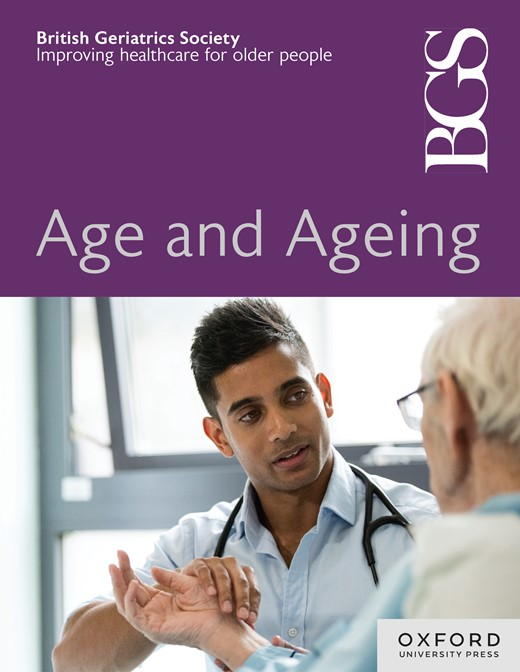Lifestyle, inflammageing, and poor physical performance in middle-aged and older adults: a prospective cohort study in Taiwan
IF 6
2区 医学
Q1 GERIATRICS & GERONTOLOGY
引用次数: 0
Abstract
Background and Aims Poor physical performance (PPP) in terms of weakness and slow walking speed is closely associated with frailty during ageing. We aimed to analyse the associations between modifiable lifestyle factors, inflammation markers (hs-CRP, D-dimer, and fibrinogen), and the odds of PPP and state transitions between normal and PPP in older adults. Methods A total of 3756 participants ($\ge$ 55 years) in wave 1 (2009–2013) and wave 2 (2014–2019) of the Healthy Aging Longitudinal Study in Taiwan (HALST) were analysed. A logistic regression model was used to assess the associations between lifestyle factors (physical activity [PA], diet, and psychosocial health), inflammation markers, comorbidities, and PPP (two or more of the criteria: grip strength, 6-minute walking distance, or gait speed among the lowest 20%). Results In total, 229 and 149 of the 773 PPP participants at wave 1 reversed and persistent in PPP state at wave 2, respectively. Higher PA (OR 0.917, 95% CI 0.894–0.941), psychosocial health (OR 0.964, 95% CI 0.955–0.972), LDL-C, and education level had significant protective effects, whereas greater waist circumference, D-dimer, fibrinogen, longer sleeping time, and comorbidities were positively associated with PPP. Higher PA, psychosocial health, and diet scores were protective against conversion to PPP, and increased PA and higher psychosocial health score were significant for reversion. Conclusions Older adults are encouraged to engage in various forms of PA and participate in societal events to increase their physical performance. To avoid further deterioration in physical frailty, screening for PPP may be adopted as a standard clinical practice for older adults.台湾中老年人生活方式、炎症与身体表现不佳:一项前瞻性队列研究
背景和目的 身体虚弱和行走速度缓慢等不良体能表现(PPP)与衰老过程中的虚弱密切相关。我们旨在分析可改变的生活方式因素、炎症标志物(hs-CRP、D-二聚体和纤维蛋白原)与老年人体能表现不良的几率以及正常与体能表现不良之间的状态转换之间的关系。方法 对台湾健康老龄化纵向研究(HALST)第一阶段(2009-2013年)和第二阶段(2014-2019年)的3756名参与者(55岁以下)进行了分析。采用逻辑回归模型评估生活方式因素(体力活动[PA]、饮食和社会心理健康)、炎症标志物、合并症和PPP(两个或两个以上标准:握力、6分钟步行距离或步速最低的20%)之间的关联。结果 在第 1 波的 773 名 PPP 参与者中,分别有 229 人和 149 人在第 2 波时逆转并持续处于 PPP 状态。较高的活动量(OR 0.917,95% CI 0.894-0.941)、社会心理健康(OR 0.964,95% CI 0.955-0.972)、低密度脂蛋白胆固醇(LDL-C)和教育水平具有显著的保护作用,而较大的腰围、D-二聚体、纤维蛋白原、较长的睡眠时间和合并症则与PPP呈正相关。较高的活动量、社会心理健康和饮食评分对转为 PPP 有保护作用,而较高的活动量和社会心理健康评分对转为 PPP 有显著影响。结论 鼓励老年人进行各种形式的体育锻炼和参加社会活动,以提高他们的体能。为避免体质虚弱进一步恶化,可将 PPP 筛查作为老年人的标准临床实践。
本文章由计算机程序翻译,如有差异,请以英文原文为准。
求助全文
约1分钟内获得全文
求助全文
来源期刊

Age and ageing
医学-老年医学
CiteScore
9.20
自引率
6.00%
发文量
796
审稿时长
4-8 weeks
期刊介绍:
Age and Ageing is an international journal publishing refereed original articles and commissioned reviews on geriatric medicine and gerontology. Its range includes research on ageing and clinical, epidemiological, and psychological aspects of later life.
 求助内容:
求助内容: 应助结果提醒方式:
应助结果提醒方式:


